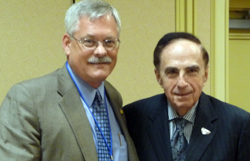What do the College of Public Health, the Center for Clinical and Translational Research and the Gold and Silver U awards have in common?
They were all ideas born and/or developed at the annual UNMC Strategic Planning Retreat.
 |
UNMC Chancellor Harold M. Maurer, M.D., right, with John Feussner, M.D., chairman of internal medicine at Medical University of South Carolina, at Thursday’s strategic planning retreat. Dr. Feussner presented on the topic of advancing clinical and translational research. |
“It’s really amazing to see what comes out of this event,” said John Adams, Ph.D., assistant vice chancellor for budget and planning. “Decisions and initiatives that come from the retreat have changed the physical and cultural landscape of the UNMC campus and helped improve health care across the state.”
Chancellor Harold M. Maurer, M.D., held the first UNMC strategic planning retreat in 1999 to allow the campus community to annually assess its goals and direction.
The event has evolved over the years, particularly in 2005 when Dr. Maurer began to host a meeting in the fall with advisers from within the UNMC community to develop what the chancellor calls the “big ideas,” which are later ironed out at the campus retreat in the spring.
|
“This is a very important day because we really plan for the rest of the year and it also lets us set our directions for the following two years,” Dr. Maurer said. “We’re only here for a few hours but a lot is accomplished.”
The two main “big ideas” discussed at Thursday’s retreat were the advancement of UNMC’s clinical and translational research capabilities and the possible formation of a center for primary care education, research and patient care.
These and other ideas were refined and incorporated into the plan for the next year and campus leaders now will work to implement the plan at all levels.
“Once the plan is finished, it really does guide us and if you’re on campus, you don’t have to look around very far to see how effective this retreat has been over the years,” Dr. Adams said.